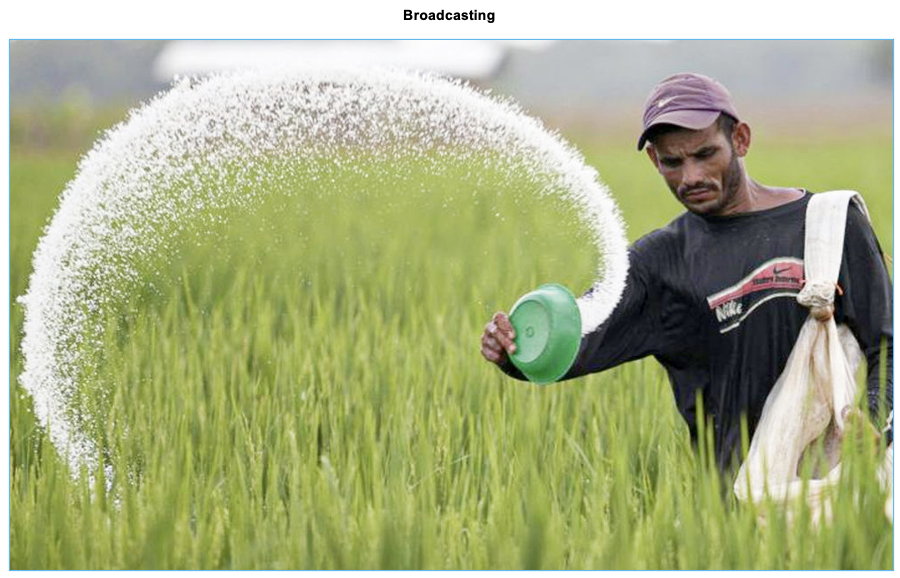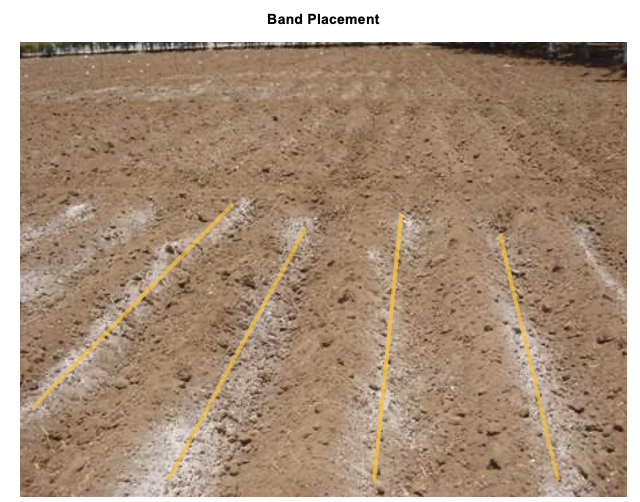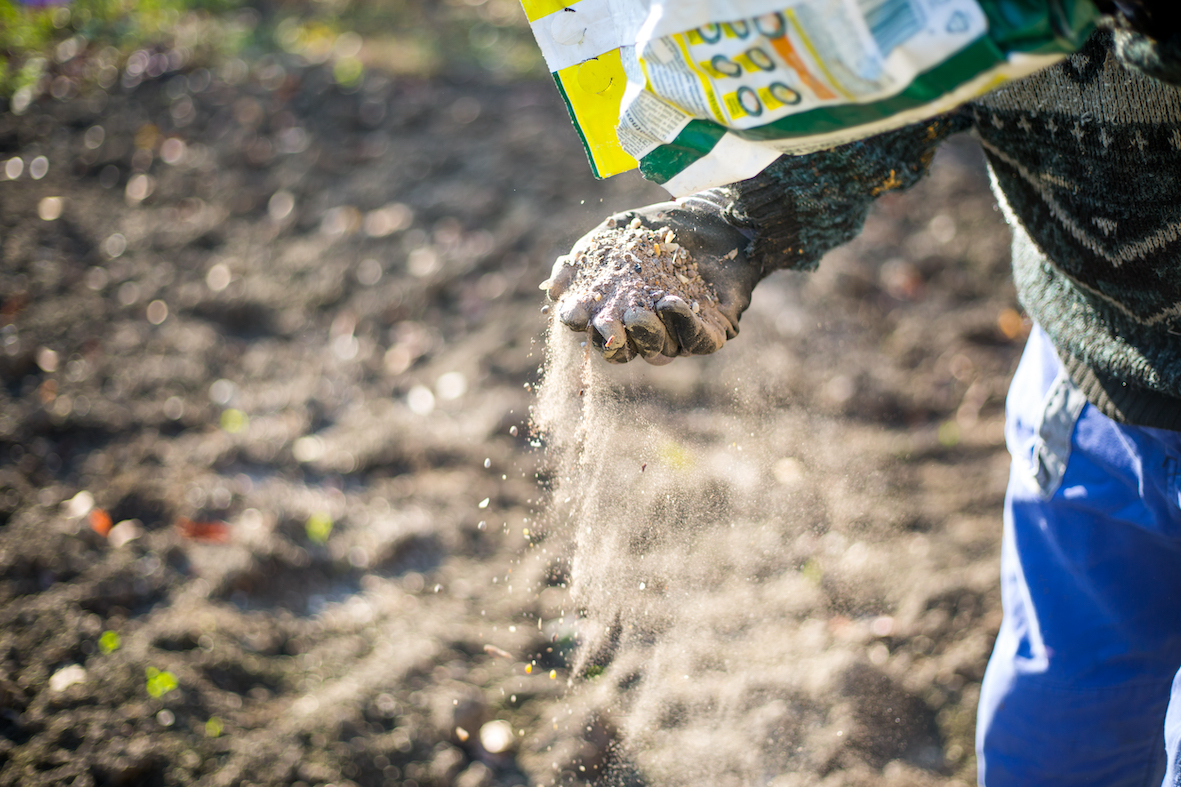
In the last three reports, we’ve discussed the importance of choosing the right synthetic fertilizer, especially within the framework of the Four Rs (Right Fertilizer, Right Application Rate and Right Timing). We’re now going to focus on the last of the four: Right Placement.
Traditional Fertilizer Placement
Traditional fertilizer placement involved an even (homogenous) spread across the field. This does not mean all parts of the field always receive the same amount of fertilizer as it can be distributed in equally spaced bands, with some areas receiving more than others.
In underdeveloped countries, manual applications are often made. In such cases, a circle of fertilizer is applied around each plant (e.g., cassava, yams and some vegetable crops). This is a common method for fertilizing trees and is frequently referred to as ‘continuous band ring placement’.
Non-homogeneous applications involve making placement adjustments across the field and are most commonly associated with precision farming, Variable Rate Technology (VRT) and associated Global Positioning Systems (GPS). We’ll take an in-depth look at VRT in the next Opinion.
Why Fertilizer Placement is Important
Things like soil type, fertility and pH levels are typically shown on a flat 2D map. However, it’s far more useful when planning fertilizer placement to think in 3D because depth is another important consideration.
Although the plants’ leaves can absorb foliar nutrients (droplets), the primary uptake is from the root system and, if the fertilizer becomes unavailable through poor placement, volatilization, leaching, loss through runoff, wastage and excessive greenhouse gas emissions are all possibilities.
Similarly, inappropriate placement of some fertilizers close to a seedling (starter fertilizer) can cause severe leaf damage or impair germination.
Crop scorch, where the leaves of a maturing plant are damaged, however, is normally the result of poor timing or wrong application rate, rather than poor placement.

Common Methods of Fertilizer Placement
Application of solid fertilizer can be carried out by broadcasting, band placement, or by pellets. Another alternative is to use liquids.
What is Broadcasting?
Broadcasting is the method of applying fertilizer as uniformly as possible across the whole field, either manually or by machine (spinning disc or oscillating spout). This method is used to encourage seedling growth and establishment (basal dressing) and for later top or side dressings on the growing crop.
From a sustainability standpoint, the method for applying basal dressing is undesirable, whereas top/side dressing, particularly with nitrogen on dense established crops, is more acceptable as the crop will rapidly use the nutrients.
The undesirability for broadcast basal (crop emergence) dressings comes as some of the nutrients (phosphorous and potassium) become locked up in the soil (fixation) and are never made available to the plant. The plants’ roots growing laterally can’t reach all the nutrients; this includes any nitrogen in the fertilizer mix. Therefore, this method of fertilization also encourages crop growth and weed growth simultaneously.
Fixation isn’t always a bad thing, however. After all, it’s the same process that allows pulses and legumes, such as soybean, peanuts and alfalfa to produce desirable nitrogen. Despite this, basal dressing is particularly wasteful and similar yields can be achieved with less and more accurate fertilizer usage.

What is Band Placement?
Band placement is where the fertilizer is applied in an orderly fashion, with or without reference to the location of the seed. With this, fixation of phosphorous and potassium is decreased compared to broadcasting.
Soil type is important in fixation. Soils that are heavily acidic or alkalic in the case of phosphorous are problematic. Soils with a higher clay content are better at fixing potassium. Incorrect placement of N will result in losses through leaching of nitrogen.
In general, band placement is far more aligned with the aims of Sustainable Agriculturalists, but it also presents some challenges. The three methods are plough sole placement, deep placement and localised placement. We explained why ploughing is undesirable in SA systems, apart from in extreme circumstances, here.
Where it is required, the fertilizer is placed at the base of the plough furrow in a continuous band, with each band covered as the next furrow is turned over. Deep band placement or even super-deep (subsoil) placement is important to SA as it’s a common method in minimum or low till systems.
In many cases, it’s important to keep the seed at a distance from the fertilize. A good rule of thumb is 3-8cm, depending on the crop and seed size. Below the seed is also better than to the side or above. This will avoid germination damage or delayed emergence caused by potassium and any nitrogen (phosphorous has no effect on germination). This needs to be balanced against placing the fertilizer too far away or unavailable to the emerging plant. Particular attention is required with pulses and legumes as seeds can easily be damaged by potassium salts. This is something farmers find difficult to get right…

Other Types of Placement
There are four other types of placement: circular, hill, row and pocket/pop-up types.
Hill placement mostly relates to trees and orchards, whereas pocket/pop-up types apply to small crop areas, such as potted plants. Row placement, where the fertilizer is applied in continuous bands on one or both sides of the row, is common in arable farming.
Pellet Application
Pellet application is mostly used on muddy soils and is especially relevant to rice farming.
Although there’s little evidence to suggest that liquid fertilizers produce higher yields than solids, liquids are mostly compatible with SA goals. The main application methods are starter solutions, foliar application, fertigation (to be discussed later under VRT), injection and occasionally aerial application.
Globally, the most common liquid application by volume is foliar. This has some specific advantages as it can provide nutrients in combination with agrochemicals at key points in the growing cycle of the plant.
Reduce Waste, Protect the Environment, Increase Yields
The Four Rs are an integral part of Sustainable Agriculture. They help reduce waste, protect the environment and improve efficiency. They also fall under the umbrella of Sustainable Intensive Agriculture (SIA) as using them correctly can actually increase yields.

Other Opinions You Might Be Interested In…
- Sustainable Agriculture: Arable Farming
- Sustainable Agriculture: Arable Nitrogen Use
- Sustainable Agriculture: Tackling Fertilizer Waste Head-On

